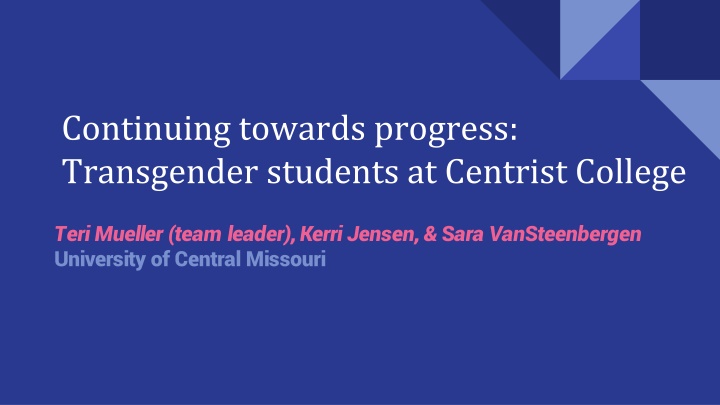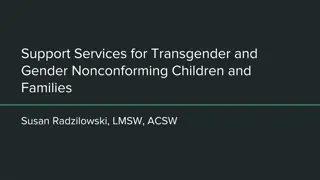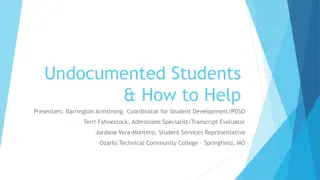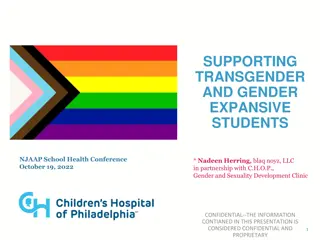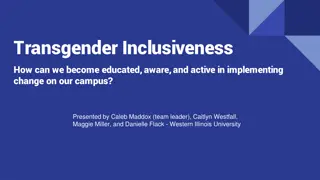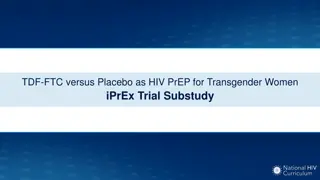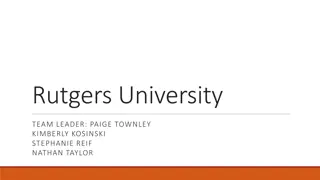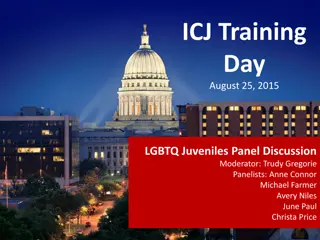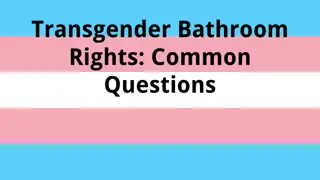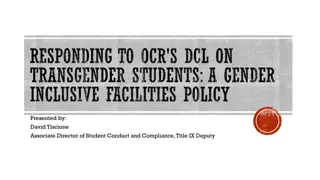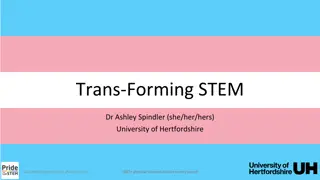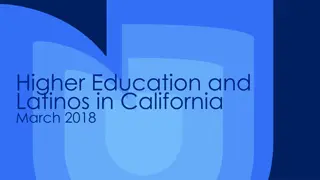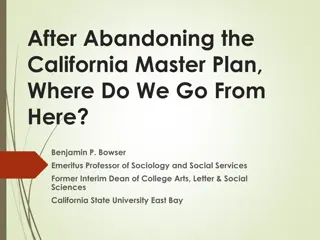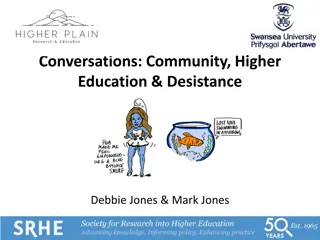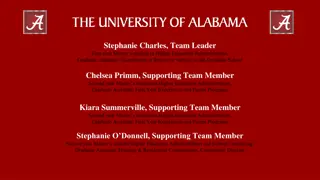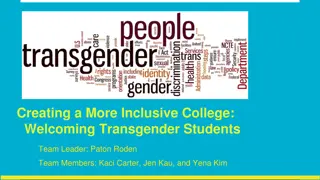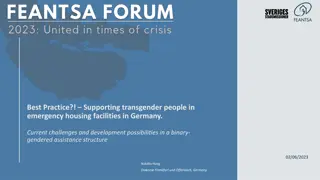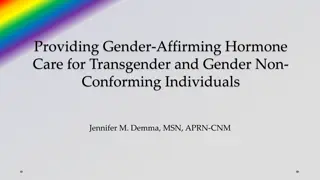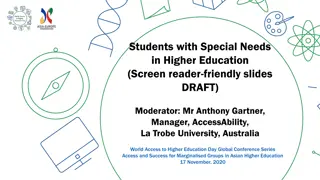Challenges Faced by Transgender Students in Higher Education
Transgender students at Centrist College, led by Teri Mueller, Kerri Jensen, and Sara VanSteenbergen from the University of Central Missouri, are pushing for progress in higher education. The presentation covers the language and definitions surrounding transgender identity, theories on gender development, and the experiences of transgender students on college campuses, including higher rates of depression, discrimination, and bullying.
Download Presentation

Please find below an Image/Link to download the presentation.
The content on the website is provided AS IS for your information and personal use only. It may not be sold, licensed, or shared on other websites without obtaining consent from the author.If you encounter any issues during the download, it is possible that the publisher has removed the file from their server.
You are allowed to download the files provided on this website for personal or commercial use, subject to the condition that they are used lawfully. All files are the property of their respective owners.
The content on the website is provided AS IS for your information and personal use only. It may not be sold, licensed, or shared on other websites without obtaining consent from the author.
E N D
Presentation Transcript
Continuing towards progress: Transgender students at Centrist College Teri Mueller (team leader), Kerri Jensen, & Sara VanSteenbergen University of Central Missouri
Presentation Overview I. Transgender Students in Higher Education II.The Current State of Centrist College III.Proposed Action Plan Ideas
I.Transgender Students: Language & Definitions Transgender : Identifying as a gender that does not conform with the normative cultural understanding of one s biological sex Cisgender: Identifying as a gender that matches one s biological sex Genderism: the way cultures expect members of a community to express gender identities in ways that align with observed sexual anatomy National Center for Transgender Equality
Individuals before Students Social Cognitive Theory of Gender: Children s and adolescents gender development is influenced by their observation and imitation of others gender behavior, as well as by the rewards and punishments they experience for gender-appropriate and gender-inappropriate behavior (Santrock, 2012, p.166) Gender Schema Theory: gender-typing emerges as children and adolescents gradually develop gender schemas of what is gender-appropriate and gender-inappropriate in their culture (Santrock, 2012, p.169) Minority Stress Theory: the increased stress faced by minority individuals leads to an increased level of psychological distress when individuals are unable to successfully increase their level of coping (Effig, Bieschke, & Locke, 2011, p.144)
Transgender Students in Higher Education Bilodeau s Transgender Identity Development (2009): Process 6 of this theory describes entering a transgender community and combating genderism Transgender students are becoming more visible in U.S. Higher Education (Evans, Forney, Guido, Patton, & Renn, 2010, p.333) This may be the first place transgender students find a community of other trans people, and college can serve as a safe space for gender identity exploration, expression, and experimentation (Evans et al., 2010, p.133)
What Transgender students face on college campuses Depression Higher rates of depression than among cisgender students (Effig et al., 2011) In one study, 46% of the surveyed transgender student population had attempted suicide (Newhouse, 2013) Discrimination & Bullying On the whole, transgender students describe their campus climates as hostile and chilly (Effig et al., 2011; Henquinet, Phibbs, & Skoglund, 2000; Newhouse, 2013) Can stem from peers, staff, and faculty Lack of access to health services (Beemyn, Curtis, Davis, & Tubbs, 2005)
What Transgender students face on campus continued Microaggressions Unconscious forms of prejudice and discrimination (Nadal, Rivera & Corpus, 2010) Social Binary divide on applications university, housing, etc. preferred pronoun pronoun Environmental Gender specific locations Bathrooms locker rooms
Strategies that have worked at other institutions ALLY Program where Trans students are empowered and become the educators for staff and faculty -including queer jeopardy (Henquinet et al., 2000) Including LGBT identification option on admission application (Henquinet et al., 2000) Programming across campus -(Beemyn et al., 2005) Support Services -LGBT organizations and faculty (Beemyn et al., 2005) Gender Inclusive Housing and bathrooms(Beemyn et al., 2005; Newhouse, 2013) College Records and Documentation (Beemyn et al., 2005)
II. Current State of Centrist College Positives: Areas where Centrist is doing well Negatives: Areas of concern at Centrist
Positives: What Centrist is doing well Acknowledging the issue Not ignoring transgender students or denying their existence Led by supportive, inquisitive, and engaged leadership Incorporation of gender neutral bathrooms Implemented 2 years ago All academic buildings have at least one All residence halls have at least one per floor
Positives: What Centrist is doing well Gender & Sexuality class offered Meets Diversity requirement for General Education curriculum Additional optional educational opportunities available Bystander intervention training Ally training
Negatives: Areas of concern at Centrist Consistency does not exist across departments Example: Gender neutral bathrooms exist but no option other than male or female exists on the application for admission No concrete effort has been made to hear the transgender student population voice Lack of housing options for transgender students
Negatives: Areas of concern at Centrist There is not a LGBTQ position in the Diversity office Educational diversity programs/trainings are not required Only 14% of students participate in optional trainings Only 33% of faculty and staff participate in optional trainings
III. Action Plan Items Explanation of Proposed Interventions Discussion
Action Plan: Policies Inclusion of gender identity in nondiscrimination/equal opportunity policy Inclusion of gender identity in hate crimes policy Addition of zero tolerance response for all hate crimes IMPLEMENTATION FACTORS Approval of policies from Board of Governors TIME FRAME Task force currently working on adjusted language Seek approval from Board of Governors at June Board meeting
Action Plan: Staffing Addition of Coordinator of LGBTQ Communication and Outreach to Diversity Center Staff IMPLEMENTATION FACTORS Approval of appointment and salary allocation from Board of Governors Development of position description Development of hiring committee TIME FRAME Diversity Center staff currently developing position description Seek approval from Board of Governors at June Board meeting
Action Plan: Accommodations Establishment of gender-inclusive locker rooms in athletic center & wellness center IMPLEMENTATION FACTORS Space allocation Construction/renovation plans and budget approval by Board of Governors and Athletic department TIME FRAME Five-year goal Present idea and consulting firm options at June Board meeting Create option for gender identity on housing application form IMPLEMENTATION FACTORS Adjustment of form within Campus Housing office TIME FRAME Class of 2020 incoming students will have new form
Action Plan: Accommodations (cont.) Allow for changes to gender and name on college records IMPLEMENTATION FACTORS Creation of a straightforward, confidential record alteration process TIME FRAME Committee including Admissions, Registrar, and Health Services in discussion Pilot roll-out: Fall 2016
Action Plan: Community Education Student, faculty, and staff training about the intricacies of gender identity IMPLEMENTATION FACTORS Determining best fit presentation style Attendance required vs. encouraged? TIME FRAME Trans students and Diversity Center staff already discussing best fit presentation Training roll-out: Fall 2016
Action Plan: Programming Day of Remembrance events IMPLEMENTATION FACTORS Efforts directed by LGBTQ Coordinator Allocation of event budget from Diversity Center & President s Auxiliary budgets Event development: Student voices Community resources TIME FRAME Planning initiatives begin when LGBTQ Coordinator is hired First event: November 2016
Action Plan: Discussion What reactions do you have to these action items? Are there any implementation factors that we have neglected? What other thoughts on interventions do you have?
References Beemyn, B. (2005). Trans on Campus: Measuring and Improving the Climate for Transgender Students. On Campus with Women,(34). Beemyn, B., Curtis, B., Davis, M., & Tubbs, N. J. (2005). Transgender Issues on College Campuses. New Directions For Student Services, (111), 49-60. Bilodeau, B. L. (2009). Genderism: Transgender students, binary systems, and higher education. Saarbrucken, Germany: Verlag. Effrig, J. C., Bieschke, K. J., & Locke, B. D. (2011). Examining Victimization and Psychological Distress in Transgender College Students. Journal Of College Counseling, 14(2), 143-157. Evans, N.J., Forney, D.S., Guido F.M., Patton, L.D., & Renn, K.A. (2010). Student development in college: Theory, research, and practice (2nded.).San Francisco, CA: Jossey-Bass. Henquinet, J., Phibbs, A., & Skoglund, B. (2000). Supporting Our Gay, Lesbian, Bisexual, and Transgender Students. About Campus, 5(5-), 24-26. Nadal, Kevin L., Rivera, David P., and Corpus, Melissa J.H. Sexual Orientation and Transgender Microaggressions: Implications for Mental Health and Counseling, in Microaggressions and Marginality: Manifestations, Dynamics and Impact, edited by Derald Wing Sue, 217-240. New Jersey: John Wiley & Sons, Inc., 2010. Newhouse, M. R. (2013). Remembering the "T" in LGBT: Recruiting and Supporting Transgender Students. Journal Of College Admission, (220), 22-27. Santrock, J. (2012). Adolescence. New York, NY: McGraw-Hill Companies.
